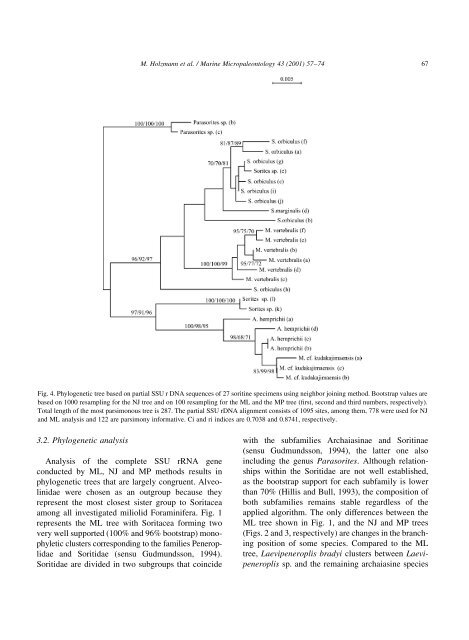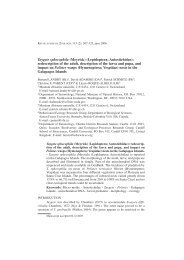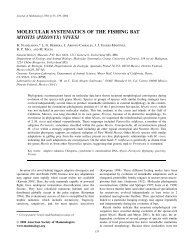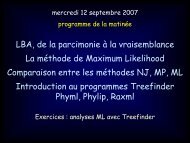Molecular phylogeny of large miliolid foraminifera - University of ...
Molecular phylogeny of large miliolid foraminifera - University of ...
Molecular phylogeny of large miliolid foraminifera - University of ...
You also want an ePaper? Increase the reach of your titles
YUMPU automatically turns print PDFs into web optimized ePapers that Google loves.
M. Holzmann et al. / Marine Micropaleontology 43 2001) 57±74 67Fig. 4. Phylogenetic tree based on partial SSU r DNA sequences <strong>of</strong> 27 soritine specimens using neighbor joining method. Bootstrap values arebased on 1000 resampling for the NJtree and on 100 resampling for the ML and the MP tree ®rst, second and third numbers, respectively).Total length <strong>of</strong> the most parsimonous tree is 287. The partial SSU rDNA alignment consists <strong>of</strong> 1095 sites, among them, 778 were used for NJand ML analysis and 122 are parsimony informative. Ci and ri indices are 0.7038 and 0.8741, respectively.3.2. Phylogenetic analysisAnalysis <strong>of</strong> the complete SSU rRNA geneconducted by ML, NJand MP methods results inphylogenetic trees that are <strong>large</strong>ly congruent. Alveolinidaewere chosen as an outgroup because theyrepresent the most closest sister group to Soritaceaamong all investigated <strong>miliolid</strong> Foraminifera. Fig. 1represents the ML tree with Soritacea forming twovery well supported 100% and 96% bootstrap) monophyleticclusters corresponding to the families Peneroplidaeand Soritidae sensu Gudmundsson, 1994).Soritidae are divided in two subgroups that coincidewith the subfamilies Archaiasinae and Soritinaesensu Gudmundsson, 1994), the latter one alsoincluding the genus Parasorites. Although relationshipswithin the Soritidae are not well established,as the bootstrap support for each subfamily is lowerthan 70% Hillis and Bull, 1993), the composition <strong>of</strong>both subfamilies remains stable regardless <strong>of</strong> theapplied algorithm. The only differences between theML tree shown in Fig. 1, and the NJand MP treesFigs. 2 and 3, respectively) are changes in the branchingposition <strong>of</strong> some species. Compared to the MLtree, Laevipeneroplis bradyi clusters between Laevipeneroplissp. and the remaining archaiasine species






